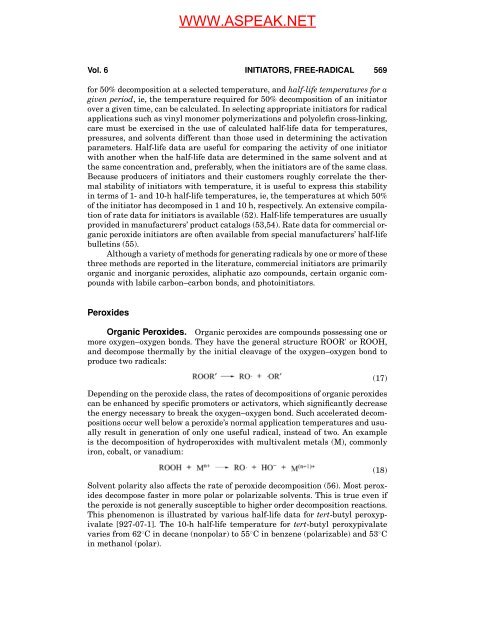"Initiators, Free-Radical". In: Encyclopedia of Polymer Science and ...
"Initiators, Free-Radical". In: Encyclopedia of Polymer Science and ...
"Initiators, Free-Radical". In: Encyclopedia of Polymer Science and ...
Create successful ePaper yourself
Turn your PDF publications into a flip-book with our unique Google optimized e-Paper software.
Vol. 6 INITIATORS, FREE-RADICAL 569<br />
for 50% decomposition at a selected temperature, <strong>and</strong> half-life temperatures for a<br />
given period, ie, the temperature required for 50% decomposition <strong>of</strong> an initiator<br />
over a given time, can be calculated. <strong>In</strong> selecting appropriate initiators for radical<br />
applications such as vinyl monomer polymerizations <strong>and</strong> polyolefin cross-linking,<br />
care must be exercised in the use <strong>of</strong> calculated half-life data for temperatures,<br />
pressures, <strong>and</strong> solvents different than those used in determining the activation<br />
parameters. Half-life data are useful for comparing the activity <strong>of</strong> one initiator<br />
with another when the half-life data are determined in the same solvent <strong>and</strong> at<br />
the same concentration <strong>and</strong>, preferably, when the initiators are <strong>of</strong> the same class.<br />
Because producers <strong>of</strong> initiators <strong>and</strong> their customers roughly correlate the thermal<br />
stability <strong>of</strong> initiators with temperature, it is useful to express this stability<br />
in terms <strong>of</strong> 1- <strong>and</strong> 10-h half-life temperatures, ie, the temperatures at which 50%<br />
<strong>of</strong> the initiator has decomposed in 1 <strong>and</strong> 10 h, respectively. An extensive compilation<br />
<strong>of</strong> rate data for initiators is available (52). Half-life temperatures are usually<br />
provided in manufacturers’ product catalogs (53,54). Rate data for commercial organic<br />
peroxide initiators are <strong>of</strong>ten available from special manufacturers’ half-life<br />
bulletins (55).<br />
Although a variety <strong>of</strong> methods for generating radicals by one or more <strong>of</strong> these<br />
three methods are reported in the literature, commercial initiators are primarily<br />
organic <strong>and</strong> inorganic peroxides, aliphatic azo compounds, certain organic compounds<br />
with labile carbon–carbon bonds, <strong>and</strong> photoinitiators.<br />
Peroxides<br />
WWW.ASPEAK.NET<br />
Organic Peroxides. Organic peroxides are compounds possessing one or<br />
more oxygen–oxygen bonds. They have the general structure ROOR ′ or ROOH,<br />
<strong>and</strong> decompose thermally by the initial cleavage <strong>of</strong> the oxygen–oxygen bond to<br />
produce two radicals:<br />
Depending on the peroxide class, the rates <strong>of</strong> decompositions <strong>of</strong> organic peroxides<br />
can be enhanced by specific promoters or activators, which significantly decrease<br />
the energy necessary to break the oxygen–oxygen bond. Such accelerated decompositions<br />
occur well below a peroxide’s normal application temperatures <strong>and</strong> usually<br />
result in generation <strong>of</strong> only one useful radical, instead <strong>of</strong> two. An example<br />
is the decomposition <strong>of</strong> hydroperoxides with multivalent metals (M), commonly<br />
iron, cobalt, or vanadium:<br />
Solvent polarity also affects the rate <strong>of</strong> peroxide decomposition (56). Most peroxides<br />
decompose faster in more polar or polarizable solvents. This is true even if<br />
the peroxide is not generally susceptible to higher order decomposition reactions.<br />
This phenomenon is illustrated by various half-life data for tert-butyl peroxypivalate<br />
[927-07-1]. The 10-h half-life temperature for tert-butyl peroxypivalate<br />
varies from 62 ◦ C in decane (nonpolar) to 55 ◦ C in benzene (polarizable) <strong>and</strong> 53 ◦ C<br />
in methanol (polar).<br />
(17)<br />
(18)



